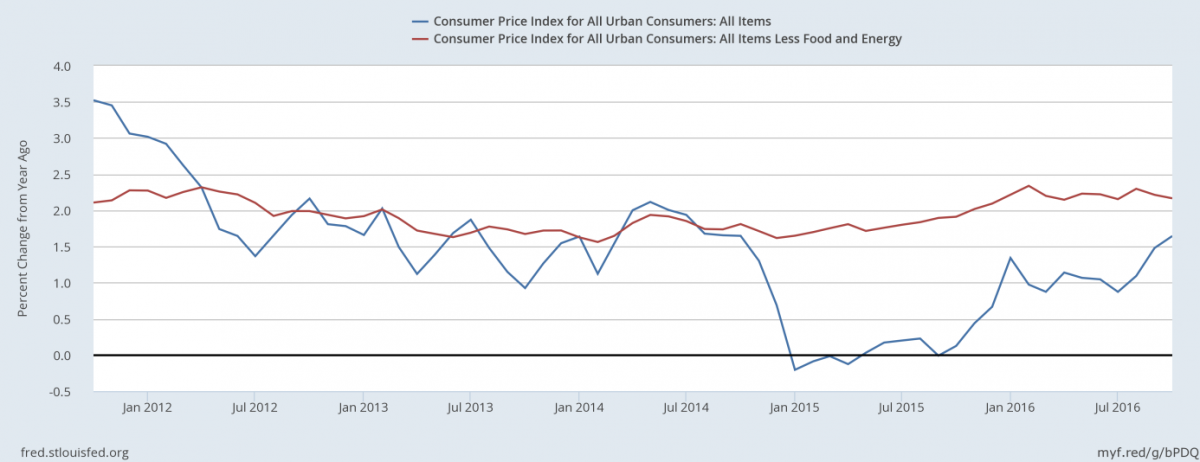October CPI, Other Data And Gold Price

The Consumer Price Index (CPI) jumped 0.4 percent in October. What does it mean for the gold market?
October CPI And Gold
Last week was full of economic data. In addition to retail sales and Yellen’s testimony already covered in the Gold News Monitors, the reports about the CPI, industrial production and housing starts were released. Let’s analyze them, starting with inflation.
Consumer prices increased 0.4 percent last month, following a 0.3 percent rise in September, according to the Bureau of Labor Statistics. The jump was mainly driven by a 3.5 percent surge in energy prices (with the gasoline index rising 7 percent). The core CPI increased 0.1 percent. On an annual basis, the index which excludes food and energy jumped 2.1 percent, while the overall CPI rose 1.6 percent, the largest increase since October 2014. Moreover, although U.S. wholesale prices were flat on a monthly basis, they rose 0.8 percent over the last 12 months, the largest annual increase since December 2014. As one can see in the chart below, the overall consumer inflation rate really accelerated since the end of last year.
Chart 1: CPI (blue line) and core CPI (red line) year-over-year from October 2011 to October 2016.
It goes without saying that the inflation data favors US monetary policy hawks who would like to hike interest rates further, which is not good news for the gold market. The market odds of an interest rate hike in December are 95.4 percent, which implies almost a full certainty that the Fed will raise interest rates at the next meeting. Having said that, investors should remember that although inflation may be coming, it would be probably lower than markets seem to assume right now.
Other Economic Data And Gold
When it comes to other data, industrial production was unchanged in October after decreasing 0.2 percent in September. Interestingly, manufacturing production rose 0.2 percent, while mining output jumped 2.1 percent (the largest gain since March 2014), but these gains were offset by a 2.6 percent drop in utilities due to the unusually warm weather which reduced the demand for heating. The Philadelphia Fed Manufacturing Index dropped from 9.7 in October to 7.6, but it remained in the positive territory.
The housing sector showed strength in October. Housing starts surged 25.5 percent in October to the highest level since 2007, following a sharp drop in September. And permits for new constructions edged up 0.3 percent. However, the Home Builders’ Index, which measures confidence in the market, was steady at 63 in November.
Conclusions
Overall, the latest economic data is negative for the gold market as it signals that the US is still growing at a moderate pace. Indeed, the leading economic index rose 0.1 percent in November. Industrial production was flat, but both mining and manufacturing rose, while housing starts surged in October. The retail sector and the labor market also were solid last month.
And the CPI jumped. Although the rise in inflation may be positive for the gold price at some point (if investors purchase gold as an inflation hedge), the markets have been expecting real GDP growth rather than mere increases in prices so far. This is why real interest rates (and the value of the US dollar) have risen recently, as one can see in the chart below.
Chart 2: The price of gold (blue line, left axis, London P.M. Fix) and 10-year US real interest rates (red line, right axis, in percent) over the last twelve months.
The increase in real interest rates and the strengthening of the greenback are fundamentally negative for the gold market. Unless these factors change (which may happen if the Trump rally fades), the outlook for gold will remain rather bearish.
Disclaimer: Please note that the aim of the above analysis is to discuss the likely long-term impact of the featured phenomenon on the price of gold and this analysis does not indicate (nor does it aim to do so) whether gold is likely to move higher or lower in the short- or medium term. In order to determine the latter, many additional factors need to be considered (i.e. sentiment, chart patterns, cycles, indicators, ratios, self-similar patterns and more) and we are taking them into account (and discussing the short- and medium-term outlook) in our trading alerts.




















